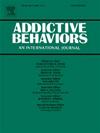Biomarkers of secondhand smoke and vaping exposure among U.S. Adolescents
IF 3.6
2区 医学
Q1 PSYCHOLOGY, CLINICAL
引用次数: 0
Abstract
Background
Despite reductions in smoking use among adults and adolescents, e-cigarette use has increased, raising a new public health concern.
Methods
We analyzed Wave 4 (2016–2018) data from the Population Assessment of Tobacco and Health (PATH) Study to assess biomarkers of exposure to secondhand smoke and vaping aerosols among U.S. adolescents (age range 12–17). Participants with no current tobacco use in the past 30 days were divided into four mutually exclusive groups: no exposure, exposure to secondhand smoke (SHS) only, exposure to secondhand aerosol (SHA) only, and dual exposure to both (SHD).
Results
Among 2,379 adolescents (mean[SD] of age = 14.4[0.02]), 1.5 % reported SHA, 18.3 % reported SHS, and 2.8 % reported SHD. Mean concentrations of cotinine were significantly higher among those exposed to SHA only (0.5 ng/mg creatinine, p = 0.04), SHS (3.0,p < 0.0001), or SHD (2.5,p < 0.0001) than among those with no exposure (0.2). As compared to the no-exposure group, both SHS and SHD groups also had higher mean concentrations of carcinogen, NNAL (4.1 and 2.8 pg/mg creatinine, respectively, vs. 0.9, p < 0.0001) and exposure to SHS had a higher level of CYMA (1.8 vs. 1.1 ng/mg creatinine, p < 0.0001). In comparison with the SHA group, the SHS and SHD groups had 6.8 and 3.6 times higher levels of cotinine and 4.6 and 2.2 times higher levels of NNAL, respectively; the SHS group also had higher levels of AAMA and CYMA.
Conclusions
Secondhand vaping aerosol poses a lower exposure risk to youth non-tobacco users than combustible cigarette smoke. The distinct exposure patterns emphasize the importance of implementing tobacco-free policies to reduce youth exposure to environments where combustible tobacco or e-cigarette use occurs.
美国青少年二手烟和电子烟暴露的生物标志物
尽管成年人和青少年的吸烟使用有所减少,但电子烟的使用却有所增加,引发了一个新的公共卫生问题。方法:我们分析了烟草与健康人口评估(PATH)研究的第4波(2016-2018)数据,以评估美国青少年(12-17岁)暴露于二手烟和雾化气溶胶的生物标志物。在过去30天内不使用烟草的参与者被分为四个相互排斥的组:不接触、仅接触二手烟(SHS)、仅接触二手气溶胶(SHA)和双重接触两者(SHD)。结果2379名青少年(平均年龄[SD] = 14.4[0.02])中有1.5%报告SHA, 18.3%报告SHS, 2.8%报告SHD。仅暴露于SHA (0.5 ng/mg肌酐,p = 0.04)、SHS (3.0 ng/mg肌酐,p <;0.0001)或SHD (2.5,p <;0.0001)比未接触者(0.2)高。与未暴露组相比,SHS组和SHD组的致癌物质NNAL平均浓度也更高(分别为4.1和2.8 pg/mg肌酐,vs. 0.9, p <;0.0001)和暴露于SHS有更高水平的CYMA (1.8 vs 1.1 ng/mg肌酐,p <;0.0001)。与SHA组相比,SHS组和SHD组可替宁含量分别高6.8倍和3.6倍,NNAL含量分别高4.6倍和2.2倍;SHS组的AAMA和CYMA水平也较高。结论二手电子烟气溶胶对青少年非烟草使用者的暴露风险低于可燃香烟烟雾。不同的接触模式强调了实施无烟政策的重要性,以减少青少年接触使用可燃烟草或电子烟的环境。
本文章由计算机程序翻译,如有差异,请以英文原文为准。
求助全文
约1分钟内获得全文
求助全文
来源期刊

Addictive behaviors
医学-药物滥用
CiteScore
8.40
自引率
4.50%
发文量
283
审稿时长
46 days
期刊介绍:
Addictive Behaviors is an international peer-reviewed journal publishing high quality human research on addictive behaviors and disorders since 1975. The journal accepts submissions of full-length papers and short communications on substance-related addictions such as the abuse of alcohol, drugs and nicotine, and behavioral addictions involving gambling and technology. We primarily publish behavioral and psychosocial research but our articles span the fields of psychology, sociology, psychiatry, epidemiology, social policy, medicine, pharmacology and neuroscience. While theoretical orientations are diverse, the emphasis of the journal is primarily empirical. That is, sound experimental design combined with valid, reliable assessment and evaluation procedures are a requisite for acceptance. However, innovative and empirically oriented case studies that might encourage new lines of inquiry are accepted as well. Studies that clearly contribute to current knowledge of etiology, prevention, social policy or treatment are given priority. Scholarly commentaries on topical issues, systematic reviews, and mini reviews are encouraged. We especially welcome multimedia papers that incorporate video or audio components to better display methodology or findings.
Studies can also be submitted to Addictive Behaviors? companion title, the open access journal Addictive Behaviors Reports, which has a particular interest in ''non-traditional'', innovative and empirically-oriented research such as negative/null data papers, replication studies, case reports on novel treatments, and cross-cultural research.
 求助内容:
求助内容: 应助结果提醒方式:
应助结果提醒方式:


